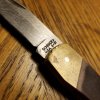My point is that I've heard reports from more than a few knife nuts who had schrade Lb7's which they couldn't get to take an edge, leading me to believe they may have had an issue with HT at some point.
I'm going to reply to post for certain on heat treatment.Schrade didn't really advertise their heat treatment as a marketing tool.But if you look in a Schrade Handbook online their Rockwell hardness for their steels is 56-59rc.Now Buck says the BOS Heat Treatment is 58rc for their 420HC-how do you know that isn't 55-58rc in truth?...here's my point.Aside from the 420HC mentioned being specifically at 58rc there's a four point differential in rc hardness on all their steels used if you look on their website.These steels used to be marketed at a specific hardness several years ago from the BOS Treatment just like 420HC is still stated at 58rc.I recall 60rc specifically for ATS-34/154CM and 61rc for S30V,but now...a four-point differential.Buck's heat treatment is no more precise than any other knife manufacturer.


